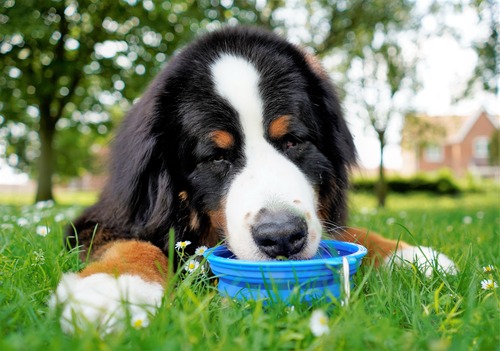It’s normal for dogs to drink water throughout the day, but if you’ve noticed your dog drinking lots of water more often than usual, it could be a sign of something worth checking out. Dogs may drink excessively because of increased activity, hot weather, or a diet high in sodium. However, excessive thirst (also called polydipsia) can also indicate an underlying medical issue. If your dog’s drinking habits seem unusual or their water bowl empties faster than normal, it’s a good idea to call Chimacum Valley Veterinary Hospital in Port Hadlock, WA, at (360) 385-4488 or schedule an appointment online for a professional evaluation.
Why Dogs Drink More Water
Dogs drink water to regulate body temperature, digest food, and stay hydrated. A sudden increase in how much water your dog drinks can have many explanations, some simple and others more serious. Understanding what might cause your dog drinking lots of water can help you decide when it’s time to reach out to your veterinarian.
Environmental and Lifestyle Factors
Changes in temperature, exercise, or diet can naturally lead to your dog drinking lots of water. Warm weather, for example, causes dogs to pant and lose moisture through evaporation, prompting them to drink more. Similarly, a long play session or a salty treat can cause temporary thirst that’s completely normal. If these factors align with the timing of your dog’s increased water intake, you might just be seeing a normal adjustment. Still, if the behavior continues after conditions return to normal, it’s best to have your veterinarian take a closer look.
Medical Causes of Excessive Thirst
When your dog’s water intake suddenly increases and doesn’t level off, an underlying health condition could be the cause. Common medical reasons for a dog drinking lots of water include:
- Diabetes mellitus – Excess glucose in the bloodstream causes dehydration, leading to excessive thirst.
- Kidney disease – The kidneys lose the ability to filter waste effectively, resulting in increased water intake and urination.
- Cushing’s disease (hyperadrenocorticism) – Overproduction of cortisol can lead to excessive thirst and frequent urination.
- Liver disease – The liver helps regulate various body functions, and when it’s impaired, it can affect your dog’s fluid balance.
- Urinary tract infection (UTI) – Inflammation or infection in the urinary system can make your dog drink more in an effort to flush out bacteria.
Because these issues can overlap in symptoms, it’s important not to assume the cause. Instead, schedule a veterinary visit so diagnostic testing can determine what’s happening.
Signs That Accompany Increased Thirst
Noticing your dog drinking lots of water is often just one part of a larger pattern. Pay attention to any other changes in behavior or physical condition, as they can help your veterinarian understand the bigger picture.
Increased Urination
One of the most common signs that accompanies excessive drinking is frequent urination. If you’re letting your dog out more often or finding more accidents indoors, it might indicate that their kidneys or hormones aren’t regulating water balance properly.
Changes in Appetite
A dog drinking lots of water and showing changes in appetite, whether eating significantly more or less, can point to metabolic or organ-related issues such as diabetes or liver dysfunction.
Lethargy or Weakness
If your dog seems unusually tired, less interested in play, or reluctant to exercise, the increase in water intake could be linked to an underlying condition affecting their energy or metabolism.
Weight Changes
Noticeable weight loss or gain, especially alongside excessive thirst, can signal a hormonal imbalance or chronic illness that needs medical evaluation. If you observe any combination of these symptoms, contact Chimacum Valley Veterinary Hospital to schedule an appointment. Our team can run simple diagnostic tests to help determine what’s causing your dog’s symptoms.
Finding Out What’s Behind Your Dog’s Excessive Thirst
When you bring your dog drinking lots of water to your veterinarian at Chimacum Valley Veterinary Hospital, they’ll start with a physical exam and discuss your dog’s daily routine, diet, and environment. This information helps narrow down possible causes.
Diagnostic Testing
Your veterinarian may recommend:
- Blood tests to assess kidney, liver, and glucose levels
- Urinalysis to evaluate hydration and rule out infection
- Imaging (X-rays or ultrasound) to check for organ changes
- Endocrine testing if hormonal imbalances are suspected
These tests provide a clearer picture of your dog’s health and guide your veterinarian in developing a care plan tailored to their needs.
Monitoring at Home
While waiting for results or following your veterinarian’s recommendations, it’s helpful to keep a log of your dog’s drinking and urination habits. Measure how much water you refill each day and note any behavior changes. This record can help your vet monitor progress or spot trends over time.
When to Call Your Veterinarian
Some situations clearly warrant a call to your veterinarian right away. You should schedule an appointment if your dog drinking lots of water is accompanied by:
- Persistent vomiting or diarrhea
- Noticeable weight loss
- Reduced appetite
- Sudden lethargy
- Cloudy or foul-smelling urine
- Panting without exercise or heat exposure
Even if your dog seems fine otherwise, a sudden or lasting increase in thirst deserves attention. Conditions like diabetes or kidney disease often develop gradually, so early detection can make a big difference in treatment outcomes. You can reach Chimacum Valley Veterinary Hospital in Port Hadlock, WA, at (360) 385-4488 or book an appointment online to have your dog examined by our caring veterinary team.
Preventive Measures for Healthy Hydration
While not all cases of your dog drinking lots of water can be prevented, you can take steps to support your pet’s hydration and overall wellness.
Provide Clean, Fresh Water
Always keep your dog’s water bowl filled with clean water. Dogs prefer cool, fresh water, and replacing it frequently encourages regular hydration.
Maintain a Consistent Diet
Sudden dietary changes or high-sodium treats can increase thirst. Stick to a consistent feeding routine and choose quality food recommended by your veterinarian.
Keep an Eye on Environmental Factors
Hot weather, heating indoors, or extra exercise can increase your dog’s water needs. Monitor how these changes affect your dog’s drinking habits and adjust as needed.
Schedule Regular Checkups
Annual wellness exams are one of the best ways to detect subtle changes in your dog’s health before they become serious. Regular testing can catch early signs of diseases that cause excessive thirst.
Addressing Your Dog’s Increased Thirst with Care
If your dog is drinking lots of water, you’re right to pay attention. Changes in water intake can reveal valuable clues about your dog’s health. Some causes are minor and temporary, while others require prompt veterinary care. When in doubt, trust your instincts. If something feels off, your veterinarian is the best source of answers. At Chimacum Valley Veterinary Hospital in Port Hadlock, WA, our team is equipped to evaluate your dog’s symptoms and provide the care they need. Call (360) 385-4488 or book an appointment online today to discuss your dog’s drinking habits and keep them feeling their best.





